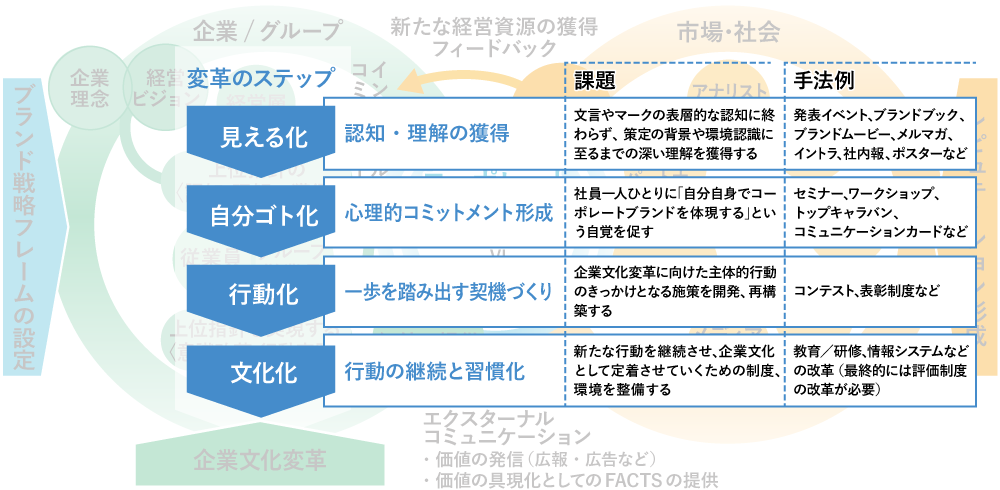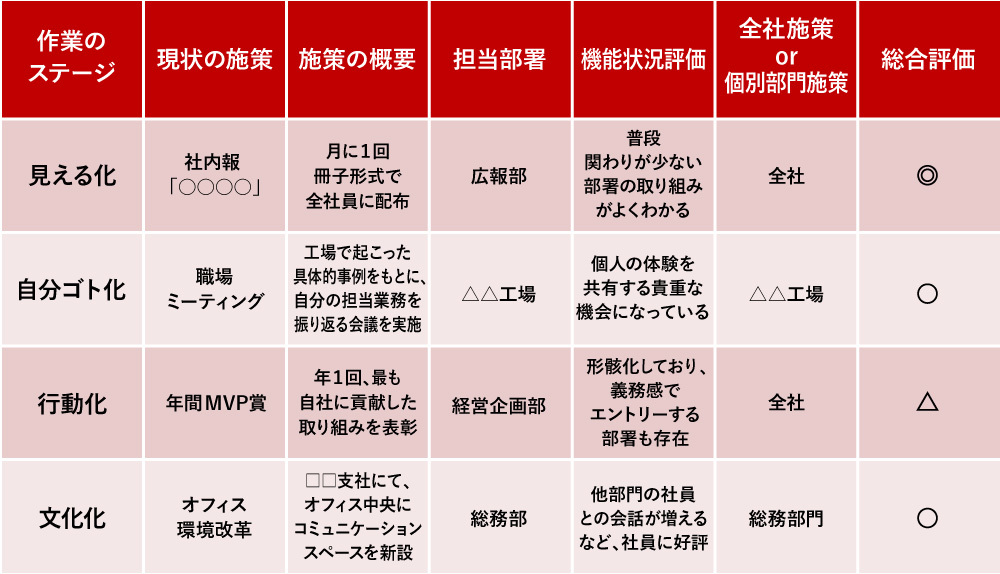This series on internal communication, which has seen renewed demand in recent years, now finally delves into the concrete process of planning initiatives.
As mentioned in previous articles, the essence of internal communication is a company-wide movement aimed at transforming corporate culture across departments. This means close collaboration between multiple departments and numerous employees is essential, and smooth consensus-building is a prerequisite for success.
Furthermore, even when advancing initiatives based on proposals from external partners, it goes without saying that the people who understand the company best are its own employees. This is a key point that significantly differentiates internal communication from marketing initiatives, which often incorporate proposals from partner companies knowledgeable about external environments, such as market insights or consumer behavior.
You may have experienced hesitation in launching an internal communication project, thinking, "Even if a partner company presents a concrete proposal based on successful examples from other companies, I somehow don't feel it will work well for us."
Drawing from my experience supporting numerous clients, this article introduces the essential mindset for developing optimal internal communication strategies tailored to your company, along with an example session.
Internal Communication: Big Ideas < Light Actions
First, let me explain the necessary mindset when considering and selecting ideas for internal communication.
Just like planning an advertising campaign, communication initiatives targeting consumers always demand "novel ideas" – the so-called "big ideas." Of course, I don't mean to deny the importance of innovative thinking or cutting-edge tools in internal communication either.
However, consider this in light of your own workplace experience. Even if some innovative initiative is launched internally, if it remains a one-off event, it won't lead to fundamental changes in awareness or behavior.
Furthermore, no matter how novel an idea is, if employees cannot perceive it as personally relevant, it risks feeling forced and even leading to a sense of disengagement. The same principle applies to communication tools. For example, many companies that introduce internal social networking platforms face challenges like low posting activity and lackluster engagement.
The most crucial aspect of internal communication is selecting appropriate measures aligned with your organization's specific challenges and driving them forward consistently. Some of these measures might seem unremarkable at first glance or lack excitement during planning meetings. However, the priority should be finding solutions that genuinely resonate – those that make employees feel, "Yes, this will change our mindset and embed the desired behaviors." Furthermore, once an initiative is launched, the ability to persistently execute it, even if immediate results aren't apparent, becomes vital.
In other words, the fundamental stance when designing internal communication initiatives is not about "big ideas" (outlandish concepts), but about "right actions" (appropriate measures).
Four Steps for Developing an Initiative Roadmap
When planning internal communication initiatives, it's essential to move beyond simply listing ideas. You need to establish an "annual roadmap" that clearly defines the purpose of each initiative and integrates them for rollout at the right time for your company. This roadmap should be developed through the following four steps:
Step 1: Inventory Current Internal Communication Initiatives
The internal communication framework introduced in Part 1 of this series, " Solving 'We Created a Vision, but the Frontlines Aren't Moving'," is shown in Figure 1.
Figure 1: Internal Communication Framework

First, take stock of your company's current internal communication initiatives from the perspectives of "Visibility," "Personalization," "Action," and "Culturalization." To do this, we recommend creating a sheet like the one below.
Figure 2: Creating an "Inventory Sheet" for Current Initiatives

Inventory all internal communication initiatives implemented within your company, including those targeting all employees, as well as local initiatives conducted individually by business units or departments whenever possible. You will likely discover that more initiatives are implemented daily than you initially thought. This alone may provide a refreshing surprise.
The key point is to evaluate these initiatives—even subjectively—to determine their effectiveness. You will likely discover some initiatives that can continue as-is, while others, though perpetuated by habit, have outlived their purpose. Through this process, the areas and directions for newly developing and introducing initiatives will also begin to emerge.
Step 2: Sharing Case Studies
Before discussing specific ideas, it's crucial to share examples of successful cases and discuss their key points. This allows you to consider and evaluate the measures your company needs from a broader perspective.
While some case studies can be researched from books or websites, considering the effort involved, we recommend collaborating with external professionals. Dentsu Inc. Corporate Communications Department also possesses a wealth of internal communication case studies, which we utilize in sessions with client companies.
For each of the four pillars—"Visualization," "Personalization," "Action," and "Culturalization"—some case studies are notable for their individual elements, while others highlight the overall design of a company's communication flow. Using these precedents as material, deepening the discussion about where the keys to success lie and what aspects could be adopted within your own company is a crucial process for building consensus on subsequent ideas.
Step 3: Discussion Using the Ideation Sheet
Now, we enter the process of generating concrete ideas. To ensure productive discussions, I recommend the following:
1. Even in sessions with external partners, have your own employees generate and contribute ideas
As mentioned at the outset, your employees understand your company best. When each project member contributes ideas, it becomes clearer where initiatives are needed. Receiving proposals from external partners on top of this enhances the accuracy of decisions regarding idea adoption.
2. Create an ideation sheet for categorization and voting.
To facilitate discussion when gathering ideas, use a standardized ideation sheet format like the one shown in Figure 3.
Figure 3: Ideation Sheet

When filling out the sheet, we recommend using visuals alongside text to share the concept. It's also crucial to create ideas not as mere whims, but by consistently considering "what" the objective is and "what effect" the proposed measure is expected to achieve.
Post each project member's ideas on the wall and vote for the ones you like. Even if feasibility is uncertain, focus first on ideas worthy of consideration.
Ideas presented can sometimes become more useful as measures when combined with ideas proposed by others. Workshop-style discussions are effective in this regard.
Step 4: Creating the Annual Roadmap
Ideas selected in Step 3 are further refined by scrutinizing them in terms of budget and feasibility. Then, compare them with your company's event calendar to determine the optimal timing for launching each initiative, creating an annual roadmap. During this process, ensure that initiatives for "Visualization," "Personalization," "Action," and "Culturalization" are organically interconnected. If any initiatives require refinement during this work, return to Step ③ for further discussion.
Furthermore, during the strategy validation process, it is crucial to clearly define which parts will be developed in-house and which will be advanced by outsourcing to external partners. Alongside creating the roadmap, refine the necessary implementation details, such as establishing working groups for each area and defining the roles and responsibilities of the assigned personnel.
While formulating measures through multiple sessions may seem like a roundabout or laborious process at first glance, engaging in discussions with members from various internal departments—rather than solely relying on proposals from external partners—clarifies the actions truly needed by your company. Furthermore, this approach facilitates smoother collaboration during the subsequent implementation phase. Internal communication, in fact, begins already at the planning stage.








